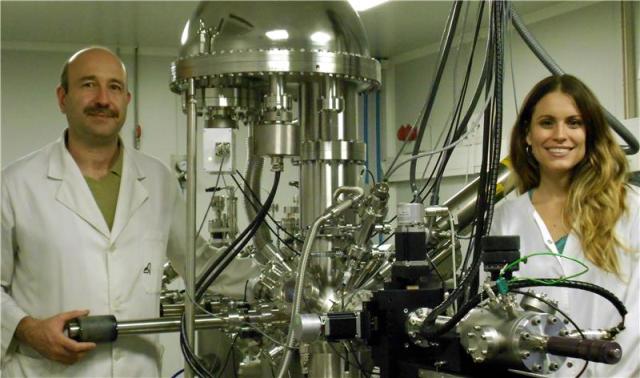 Researchers Jordi Llorca and Núria Jiménez at the laboratory of the UPC's Nanoengineering Research Centre (CRnE).
Researchers Jordi Llorca and Núria Jiménez at the laboratory of the UPC's Nanoengineering Research Centre (CRnE).
Catalysts increase the rate of chemical reactions. They can help to reduce the amount of energy that is required to trigger a reaction and also to reduce the amount of pollution from gases released in combustion engines. This research could also help in the design of new catalysts for industrial, energy applications and for the elimination of pollutant gases.
The research team studied the movement and behaviour of atoms in an actual catalyst. They demonstrated that based on the type of support provided, the reaction takes place in a unique manner.
The Dendrimers and Molecular Polygons Group at the University of Barcelona (UB) prepared a custom-made catalyst containing rhodium and palladium metal nanoparticles. The researchers fixed these nanoparticles to a ceria support.
This custom-made catalyst can effectively produce hydrogen, which could be used as a replacement for fossil fuels. This study helps obtain hydrogen from water and ethanol in a very efficient manner. Ethanol is a renewable energy source that is easily available from agricultural and forestry waste.
The ALBA synchrotron’s CIRCE beamline, particularly the near ambient pressure photoemission (NAPP), was used in this study. Previously, researchers had used the X-ray photoelectron spectroscopy chamber at UPC's Nanoengineering Research Centre (CRnE) to find out the reaction that occurs when molecules of water and ethanol were heated to 550°C. The ALBA synchrotron helped observe the atom movement in the nanoparticles accurately during the reactions.
The shortest route is to climb up one side and then down the other, but this option is the one that requires the greatest amount of energy. If we find a better way to cross the mountain, although it may seem longer it will require less energy and therefore we will get across the mountain faster.
Jordi Llorca, Professor at the Universitat Politècnica de Catalunya
Based on the catalytic support’s characteristics, the behaviour of the nanoparticles changed. This in turn could affect their nanostructure, form and composition. In order to produce hydrogen, the atoms in the catalyst had to be in specific positions.
These positions enabled electron-exchange between the ceria support and the metal nanoparticles in the manner desired so as to form new chemical bonds for producing hydrogen.
Combustion engines with ceria-supported catalysts are used in many vehicles and new nanostructures could help increase their energy efficiency. This study has been published in the journal Science.